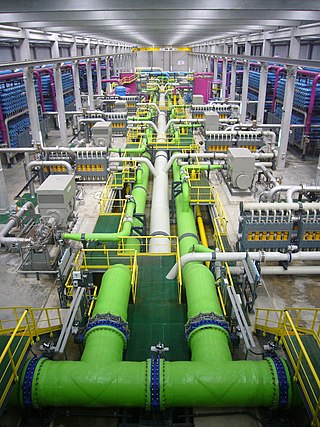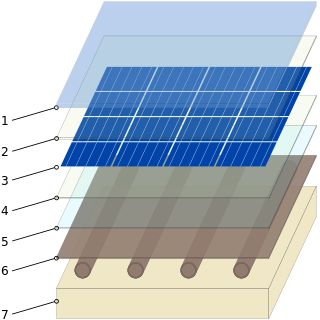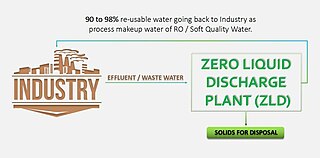A solar-powered desalination unit produces potable water from saline water through direct or indirect methods of desalination powered by sunlight. Solar energy is the most promising renewable energy source due to its ability to drive the more popular thermal desalination systems directly through solar collectors and to drive physical and chemical desalination systems indirectly through photovoltaic cells. [1]
Direct solar desalination produces distillate directly in the solar collector. An example would be a solar still which traps the Sun's energy to obtain freshwater through the process of evaporation and condensation. Indirect solar desalination incorporates solar energy collection systems with conventional desalination systems such as multi-stage flash distillation, multiple effect evaporation, freeze separation or reverse osmosis to produce freshwater. [2]
One type of solar desalination unit is a solar still, it is also similar to a condensation trap. A solar still is a simple way of distilling water, using the heat of the Sun to drive evaporation from humid soil, and ambient air to cool a condenser film. Two basic types of solar stills are box and pit stills. In a pit still, impure water is contained outside the collector, where it is evaporated by sunlight shining through clear plastic. The pure water vapor condenses on the cool inside plastic surface and drips down from the weighted low point, where it is collected and removed. The box type is more sophisticated. The basic principles of solar water distillation are simple, yet effective, as distillation replicates the way nature makes rain. The sun's energy heats water to the point of evaporation. As the water evaporates, water vapor rises, condensing on the glass surface for collection. This process removes impurities, such as salts and heavy metals, and eliminates microbiological organisms. The end result is water cleaner than the purest rainwater.[ citation needed ]
Indirect solar desalination systems comprise two sub-systems: a solar collection system and a desalination system. The solar collection system is used, either to collect heat using solar collectors and supply it via a heat exchanger to a thermal desalination process, or to convert electromagnetic solar radiation to electricity using photovoltaic cells to power an electricity-driven desalination process.
Osmosis is a natural phenomenon in which water passes through a membrane from a lower to a higher concentration solution. The flow of water can be reversed if a pressure larger than the osmotic pressure is applied on the higher concentration side. In Reverse osmosis desalination systems, seawater pressure is raised above the natural osmotic pressure, forcing pure water through membrane pores to the fresh water side. Reverse osmosis (RO) is the most common desalination process in terms of installed capacity due to its superior energy efficiency compared to thermal desalination systems, despite requiring extensive water pre-treatment. Furthermore, part of the consumed mechanical energy can be reclaimed from the concentrated brine effluent with an energy recovery device. [1]
Solar-powered RO desalination is common in demonstration plants due to the modularity and scalability of both photovoltaic (PV) and RO systems. A detailed economic analysis [3] and a thorough optimisation strategy [4] of PV powered RO desalination were carried out with favorable results reported. Economic and reliability considerations are the main challenges to improving PV powered RO desalination systems. However, the quickly dropping PV panel costs are making solar-powered desalination ever more feasible.
A solar powered desalination unit designed for remote communities has been tested in the Northern Territory of Australia. The "reverse-osmosis solar installation" (ROSI) uses membrane filtration to provide a reliable and clean drinking water stream from sources such as brackish groundwater. Solar energy overcomes the usually high-energy operating costs as well as greenhouse emissions of conventional reverse osmosis systems. ROSI can also remove trace contaminants such as arsenic and uranium that may cause certain health problems, and minerals such as calcium carbonate which causes water hardness. [5]
Project leader Dr Andrea Schaefer from the University of Wollongong's Faculty of Engineering said ROSI has the potential to bring clean water to remote communities throughout Australia that do not have access to a town water supply and/or the electricity grid. [5]
Groundwater (which may contain dissolved salts or other contaminants) or surface water (which may have high turbidity or contain microorganisms) is pumped into a tank with an ultrafiltration membrane, which removes viruses and bacteria. This water is fit for cleaning and bathing. Ten percent of that water undergoes nanofiltration and reverse osmosis in the second stage of purification, which removes salts and trace contaminants, producing drinking water. A photovoltaic solar array tracks the Sun and powers the pumps needed to process the water, using the plentiful sunlight available in remote regions of Australia not served by the power grid. [6]
Solar photo voltaic power is considered a viable option to power a reverse osmosis desalination plant. The techno-economics both in standalone mode and in PV-biodisel hybrid mode for capacities from 0.05 MLD to 300 MLD were examined by researchers at IIT Madras. As a technology demonstrator, a plant of 500 litre /day capacity has been designed, installed and functional there. [7]
While the intermittent nature of sunlight and its variable intensity throughout the day makes desalination during nighttime challenging, several energy storage options can be used to permit 24 hour operation. Batteries can store solar energy for use at night. Thermal energy storage systems ensure constant performance at night or on cloudy days, improving overall efficiency. [8] Alternatively, stored gravitational energy can be harnessed to provide energy to a solar-powered reverse osmosis unit during non-sunlight hours.[ citation needed ]

Solar energy is radiant light and heat from the Sun that is harnessed using a range of technologies such as solar power to generate electricity, solar thermal energy, and solar architecture. It is an essential source of renewable energy, and its technologies are broadly characterized as either passive solar or active solar depending on how they capture and distribute solar energy or convert it into solar power. Active solar techniques include the use of photovoltaic systems, concentrated solar power, and solar water heating to harness the energy. Passive solar techniques include orienting a building to the Sun, selecting materials with favorable thermal mass or light-dispersing properties, and designing spaces that naturally circulate air.

Brine is water with a high-concentration solution of salt. In diverse contexts, brine may refer to the salt solutions ranging from about 3.5% up to about 26%. Brine forms naturally due to evaporation of ground saline water but it is also generated in the mining of sodium chloride. Brine is used for food processing and cooking, for de-icing of roads and other structures, and in a number of technological processes. It is also a by-product of many industrial processes, such as desalination, so it requires wastewater treatment for proper disposal or further utilization.

Desalination is a process that takes away mineral components from saline water. More generally, desalination is the removal of salts and minerals from a target substance, as in soil desalination, which is an issue for agriculture. Saltwater is desalinated to produce water suitable for human consumption or irrigation. The by-product of the desalination process is brine. Desalination is used on many seagoing ships and submarines. Most of the modern interest in desalination is focused on cost-effective provision of fresh water for human use. Along with recycled wastewater, it is one of the few rainfall-independent water resources.

Forward osmosis (FO) is an osmotic process that, like reverse osmosis (RO), uses a semi-permeable membrane to effect separation of water from dissolved solutes. The driving force for this separation is an osmotic pressure gradient, such that a "draw" solution of high concentration, is used to induce a net flow of water through the membrane into the draw solution, thus effectively separating the feed water from its solutes. In contrast, the reverse osmosis process uses hydraulic pressure as the driving force for separation, which serves to counteract the osmotic pressure gradient that would otherwise favor water flux from the permeate to the feed. Hence significantly more energy is required for reverse osmosis compared to forward osmosis.

A solar still distills water with substances dissolved in it by using the heat of the Sun to evaporate water so that it may be cooled and collected, thereby purifying it. They are used in areas where drinking water is unavailable, so that clean water is obtained from dirty water or from plants by exposing them to sunlight.
Multi-stage flash distillation (MSF) is a water desalination process that distills sea water by flashing a portion of the water into steam in multiple stages of what are essentially countercurrent heat exchangers. Current MSF facilities may have as many as 30 stages.
This is a list of solar energy topics.
Solar desalination is a desalination technique powered by solar energy. The two common methods are direct (thermal) and indirect (photovoltaic).

Electrodialysis (ED) is used to transport salt ions from one solution through ion-exchange membranes to another solution under the influence of an applied electric potential difference. This is done in a configuration called an electrodialysis cell. The cell consists of a feed (dilute) compartment and a concentrate (brine) compartment formed by an anion exchange membrane and a cation exchange membrane placed between two electrodes. In almost all practical electrodialysis processes, multiple electrodialysis cells are arranged into a configuration called an electrodialysis stack, with alternating anion and cation-exchange membranes forming the multiple electrodialysis cells. Electrodialysis processes are different from distillation techniques and other membrane based processes in that dissolved species are moved away from the feed stream, whereas other processes move away the water from the remaining substances. Because the quantity of dissolved species in the feed stream is far less than that of the fluid, electrodialysis offers the practical advantage of much higher feed recovery in many applications.

Osmotic power, salinity gradient power or blue energy is the energy available from the difference in the salt concentration between seawater and river water. Two practical methods for this are reverse electrodialysis (RED) and pressure retarded osmosis (PRO). Both processes rely on osmosis with membranes. The key waste product is brackish water. This byproduct is the result of natural forces that are being harnessed: the flow of fresh water into seas that are made up of salt water.

A reverse osmosis plant is a manufacturing plant where the process of reverse osmosis takes place. Reverse osmosis is a common process to purify or desalinate contaminated water by forcing water through a membrane. Water produced by reverse osmosis may be used for a variety of purposes, including desalination, wastewater treatment, concentration of contaminants, and the reclamation of dissolved minerals. An average modern reverse osmosis plant needs six kilowatt-hours of electricity to desalinate one cubic metre of water. The process also results in an amount of salty briny waste. The challenge for these plants is to find ways to reduce energy consumption, use sustainable energy sources, improve the process of desalination and to innovate in the area of waste management to deal with the waste. Self-contained water treatment plants using reverse osmosis, called reverse osmosis water purification units, are normally used in a military context.

A pressure exchanger transfers pressure energy from a high pressure fluid stream to a low pressure fluid stream. Many industrial processes operate at elevated pressures and have high pressure waste streams. One way of providing a high pressure fluid to such a process is to transfer the waste pressure to a low pressure stream using a pressure exchanger.
Reverse osmosis (RO) is a water purification process that uses a semi-permeable membrane to separate water molecules from other substances. RO applies pressure to overcome osmotic pressure that favors even distributions. RO can remove dissolved or suspended chemical species as well as biological substances, and is used in industrial processes and the production of potable water. RO retains the solute on the pressurized side of the membrane and the purified solvent passes to the other side. It relies on the relative sizes of the various molecules to decide what passes through. "Selective" membranes reject large molecules, while accepting smaller molecules.

Photovoltaic thermal collectors, typically abbreviated as PVT collectors and also known as hybrid solar collectors, photovoltaic thermal solar collectors, PV/T collectors or solar cogeneration systems, are power generation technologies that convert solar radiation into usable thermal and electrical energy. PVT collectors combine photovoltaic solar cells, which convert sunlight into electricity, with a solar thermal collector, which transfers the otherwise unused waste heat from the PV module to a heat transfer fluid. By combining electricity and heat generation within the same component, these technologies can reach a higher overall efficiency than solar photovoltaic (PV) or solar thermal (T) alone.

Australia is the driest habitable continent on Earth and its installed desalination capacity has been increasing. Until a few decades ago, Australia met its demands for water by drawing freshwater from dams and water catchments. As a result of the water supply crisis during the severe 1997–2009 drought, state governments began building desalination plants that purify seawater using reverse osmosis technology. Approximately one percent of the world's drinkable water originates from desalination plants.
Membrane distillation (MD) is a thermally driven separation process in which separation is driven by phase change. A hydrophobic membrane presents a barrier for the liquid phase, allowing the vapour phase to pass through the membrane's pores. The driving force of the process is a partial vapour pressure difference commonly triggered by a temperature difference.
The following outline is provided as an overview of and topical guide to solar energy:

Zero Liquid Discharge(ZLD) is a classification of water treatment processes intended to reduce wastewater efficiently and produce clean water that is suitable for reuse (e.g., irrigation). ZLD systems employ wastewater treatment technologies and desalination to purify and recycle virtually all wastewater received.

A solar-assisted heat pump (SAHP) is a machine that combines a heat pump and thermal solar panels and/or PV solar panels in a single integrated system. Typically these two technologies are used separately to produce hot water. In this system the solar thermal panel performs the function of the low temperature heat source and the heat produced is used to feed the heat pump's evaporator. The goal of this system is to get high COP and then produce energy in a more efficient and less expensive way.
The low-temperature distillation (LTD) technology is the first implementation of the direct spray distillation (DSD) process. The first large-scale units are now in operation for desalination. The process was first developed by scientists at the University of Applied Sciences in Switzerland, focusing on low-temperature distillation in vacuum conditions, from 2000 to 2005.
{{cite book}}: |journal= ignored (help)